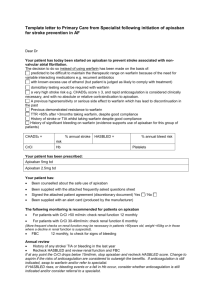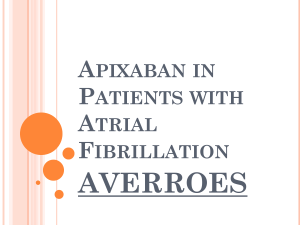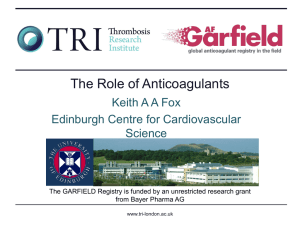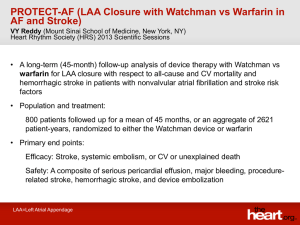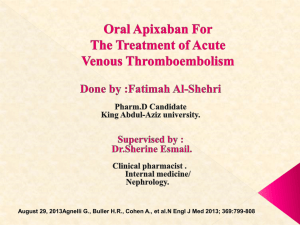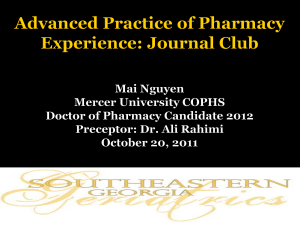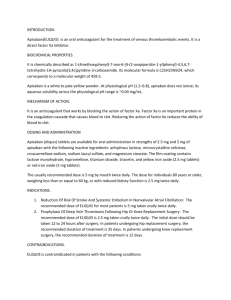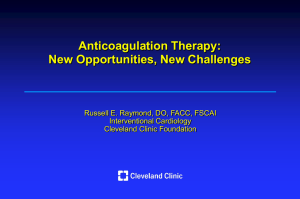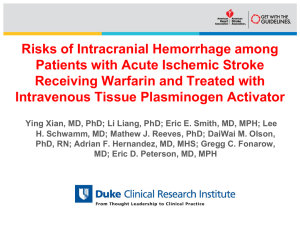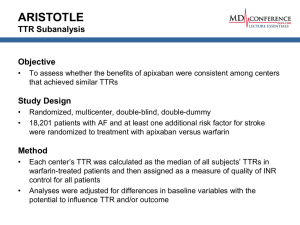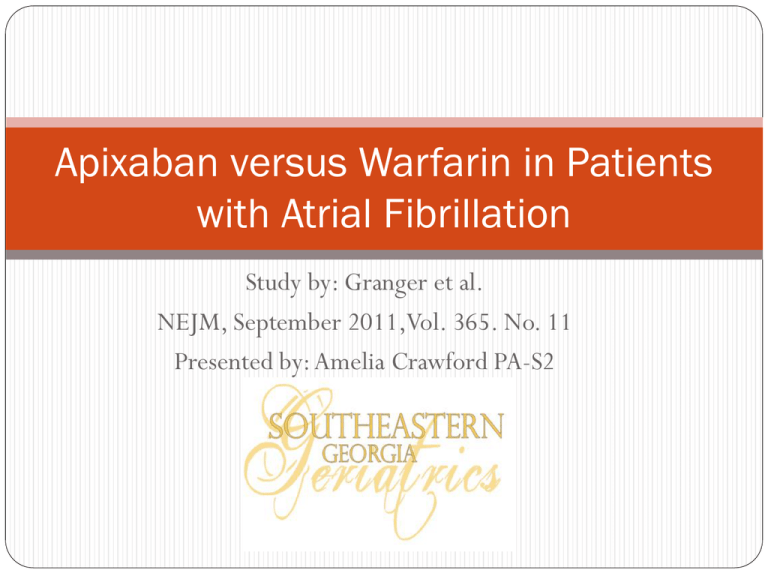
Apixaban versus Warfarin in Patients
with Atrial Fibrillation
Study by: Granger et al.
NEJM, September 2011,Vol. 365. No. 11
Presented by: Amelia Crawford PA-S2
Background
Vitamin K Antagonists (Warfarin) are routinely used in stroke
prevention in patients with A.fib
Downfalls of Warfarin:
1. variable response
2. requires regular monitoring (INR)
3. bleeding risks
4. food & drug interactions
Apixaban is a direct factor Xa inhibitor that has demonstrated stroke
risk reduction in patients compared with Aspirin and does not require
INR monitoring
Objectives
Primary: To determine whether Apixaban was non-inferior to
Warfarin in decreasing the rate of stroke/systemic embolism in
patients with A.fib and at least one additional risk factor for
stroke.
Non-Inferiority Hypothesis: Apixaban preserves at least 50%
of relative risk reduction in the risk of stroke or systemic embolism
associated with Warfarin
Secondary: Determine if Apixaban was superior to Warfarin
with respect to primary outcome and rates of major bleeding and
death.
Design
Randomized, Double Blind Trial
ARISTOTLE Trial- December 2006 to April 2010 funded by
Bristol-Myers, Squibb and Pfizer
Study Population
18,201 patients from 1034 clinical sites in 39 countries w/ 2 year
follow up
Patients with a.fib or flutter + one additional risk factor for stroke:
75 YOA or older,
prior history of stroke, TIA, or systemic embolism
symptomatic HF within 3 months or LVEJ<40%
DM
HTN requiring pharmacologic therapy
9120 patients assigned to Apixaban and 9081 assigned to Warfarin
Patients were similar in baseline characteristics: age, CHAD score,
previous anticoagulation treatment, hx of stroke, etc)
Exclusion Criteria
reversible a.fib
severe mitral stenosis
other conditions requiring anti-coagulation (prosthetic heart valve)
stroke within previous 7 days
need for >165mg ASA daily or both ASA & clopidiogrel
renal insufficiency (SCr >2.5mg/dl or CrCl <25ml/min)
Interventions
Patients were randomized to receive either:
2mg doses of Warfarin in order to achieve INR between 2-3.
Apixaban 5mg BID
Apixaban 2.5mg BID if patient had 2 of the following:
> 80YOA
Body weight of 60kg or <
Serum Creatinine of 1.5mg/dl or >
Patients received monthly study visits to monitor INR
INR’s were monitored using blinded, encrypted point of care
INR device, and an algorithm was used to guide warfarin dose
Patients were visited every 3 months to assess clinical outcomes
& adverse events.
Outcomes
Primary Efficacy Outcome= Stroke or Systemic Embolism
Secondary Efficacy Outcome= Death from any cause
Primary Safety Outcome= Major bleeding (required transfusion or
resulted in death)
Secondary Safety Outcome= Non-major bleeding that required
medical care
Statistical Analysis
Primary & Secondary analyses performed using the Cox
proportional hazards model
Results
Primary Efficacy Outcomes:
Primary outcome of stroke or systemic embolism was lower for
Apixaban group than Warfarin group:
212 pts in apixaban, 265 pts in warfarin,
HR = 0.79; CI 0.66-0.95; P<0.001 for noninferiority & P = 0.01 for
superiority
Reduction in primary outcome with Apixaban was consistent
across all major subgroups (age, sex, weight, type of a.fib, dm,
hf, prior stroke/tia, renal impairment)
Results
Secondary Efficacy Outcomes:
Death rate lower in Apixaban group than in Warfarin group:
3.52% vs 3.94% per year: HR 0.89; 95% CI, 0.80-0.99; P= 0.047
Results
Primary Safety Outcomes:
Major Bleeding was lower in Apixaban group (2.13%) compared
with Warfarin group (3.09%)
HR= 0.69; 95% CI, 0.60-0.80; P<0.001
Rate of any bleeding was 18.1% with Apixaban and 25.8% with
Warfarin, with an absolute risk reduction of 7.7 percentage points
(P<0.001)
Outcome
Patients
w/ Event
Event
Rate
Patients
w/Event
Event Rate
Hazard Ratio
P
Value
(A)
(A)
(W)
(W)
Stroke or SE:
Ischemic
Hemorrhagic
Systemic
Embolism
212
162
40
15
1.27 %/yr
0.97
0.24
0.09
265
175
78
17
1.60 %/yr
1.05
0.47
0.10
0.79 (0.66–0.95)
0.92 (0.74–1.13)
0.51 (0.35–0.75)
0.87 (0.44–1.75)
0.01
0.4
<0.001
0.047
Death from
any Cause
603
3.52 %/yr
699
3.94%/yr
0.89 (0.80–0.998)
0.047
Calculations for Primary Outcome
Relative Risk = 0.79
Apixaban= 212/9120 = 0.023
Warfarin = 265/9081 = 0.029
Relative Risk Reduction= 0.21
1- 0.79
Absolute Risk Reduction = 0.006
0.029-0.023
NNT= 167 patients
1/0.006
NNH (Major Bleeding) = 67
NNH (Death) = 125
Summary of Results
In patients with A.fib + one or more risk factors for stroke, the
use of Apixaban compared with Warfarin, significantly reduced the
risk of:
1. Stroke/Systemic Embolism (21% decrease)
2. Major Bleeding (31% decrease)
3. Death (11% decrease)
Results were consistent across subgroups
Predominant effect is hemorrhagic stroke prevention (49% lower rate
than warfarin)
Conclusions
In patients with A.fib, Apixaban is as effective as Warfarin at
preventing stroke & systemic embolism, causes less bleeding, and
results in lower mortality.
Advantages of Apixaban: rapid absorption, 12hr half-life,
25% renal excretion, no need for INR monitoring
Other options on the horizon:
1. Dabigatran- Direct Thrombin Inhibitor
2. Rivaroxaban- Factor Xa Inhibitor
All 3 have been shown to be non-inferior to Warfarin in stroke
prevention

